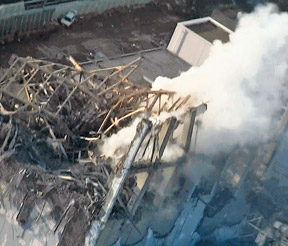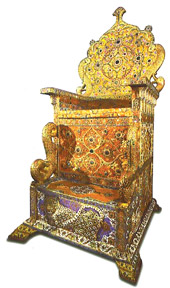|
Full blown nuke disaster looms:
Resilience of Japanese people
Gaston de Rosayro
 The entire world’s prayers and thoughts are with the Japanese people
as the nation faces an unprecedented multiple crisis of earthquake,
tsunami and radiation leak. The tsunami and quake all along the
pulverised north-east of Japan’s Pacific coastline, wiped out farms,
factories, villages and whole towns. It drove everything in its path
inland, in some instances by two or more kilometres while carrying
thousands of people back to a watery grave. The entire world’s prayers and thoughts are with the Japanese people
as the nation faces an unprecedented multiple crisis of earthquake,
tsunami and radiation leak. The tsunami and quake all along the
pulverised north-east of Japan’s Pacific coastline, wiped out farms,
factories, villages and whole towns. It drove everything in its path
inland, in some instances by two or more kilometres while carrying
thousands of people back to a watery grave.
But for the moment there is no time for mourning the dead and the
missing or worrying about the consequences of the damage. The wreckage
and heartbreaking loss of human life have almost been overshadowed by
the nuclear crisis that has unfolded in Fukushima Prefecture, which
calls into question the safety of Japan’s entire nuclear industry.
Crisis
As the crisis at the Fukushima unfolds the inevitable comparisons
with the 1979 Three Mile Island emergency in Harrisburg Pennsylvania and
the catastrophe in Chernobyl, Ukraine, that unfolded seven years later,
have begun rolling in. Japan’s nuclear safety agency last week raised
the severity level of the Fukushima Daiichi nuclear power station to 5
from 4 on a 7-level international scale.
|

Chernobyl victims after thyroid cancer surgery |
The provisional evaluation would mean that the country’s disaster has
come to the same level as the Three Mile Island accident. Only two
events rank higher, including the 1986 Chernobyl disaster, the only
accident to be rated a 7.
Even as the search for bodies goes on, economists and insurers are
calculating the mind-boggling costs of the clean-up: And then there is
the awful human drama - nearly half a million homeless, perhaps 10,000
dead, many thousands more injured and the terrifying prospect – not
unthinkable – of thousands more deaths from radiation-related cancer.
The crisis will return safety to the forefront of the nuclear power
debate. Even the most ardent industry advocates now recognize that the
unfolding drama inside reactors there – shown on live television and
beamed around the world – has left the future of their industry in
doubt.
Nevertheless, the case for nuclear power remains strong. All forms of
energy generation carry risks. Fossil fuels, which (for the time being
at least) are nuclear energy’s principal rival, carry the risk of
catastrophic climate change. And as we’re seeing in Japan, we have not
eliminated all the dangers associated with nuclear power, even though
accidents are few and far between.
Risks
Good public policy involves balancing these risks. Persuading the
public to accept the risks of nuclear energy will, however, not be easy.
To do so, the nuclear industry will have to resist a strong temptation
to argue that the accident in Japan was simply an extraordinarily
improbable confluence of events and that everything is just fine.
Instead, it must recognize and correct the deficiencies of its current
approach to safety.
But what of the trauma? What effect will it have on the people and
their nation? Not surprisingly, the debate has already begun: Can this
battered nation ever rise again? Japan had, after all, been sliding for
two decades before the Pacific tectonic plates shifted with such
explosive force – its economy overtaken by China, its population ageing
and its people saddled with the developed world’s largest public debt.
But again this is also a nation that has a remarkable, perhaps
unique, history of rebirth after destruction on a biblical scale. In
1923, a 7.9-quake and tsunami famously levelled much of Yokohama and
Tokyo, killing at least 100,000 people; the anniversary of the tragedy.
Quakes have regularly brought the city to its knees and even the
national icon, Mt Fuji, looms threateningly 100km away, always ready to
spew ash down on the world’s largest metropolis.
Nature hasn’t been the only assailant. In March 1945 US bombers
dropped close to half a million incendiary bombs on sleeping Tokyo,
reducing 40 sq km of the city to cinders and killing 100,000 people. It
was then the largest mass killing of the Second World War, dwarfing even
the destruction of the German city of Dresden the previous month.
History
The firebombing of Tokyo, one of the great forgotten war crimes, was
of course part of a much larger American strategy that included dozens
of similar raids on Japanese cities and culminated in the atomic bombing
of Hiroshima and Nagasaki in August of the same year.
By the end of the war, nearly 70 cities had been reduced to rubble
and well over half a million people, mostly civilians, had been killed.
The war killed about four million Japanese, wiped out a quarter of the
nation’s national wealth. Yet, the country engineered probably the most
remarkable feat of economic regeneration in history, transforming itself
in just three decades into the world’s second-largest economy. This
achievement was called the Japanese economic miracle.
Bouncing back
Even among those who lament the monumental folly of the Pacific War,
there is enormous admiration for Japan’s ability to dust itself off from
tragedy and start again. If there is a single word to describe the
Japanese people it is resilience.
One reason for this resilience is the natural environment: after
millennia of quakes, tsunamis and volcanoes, Japan is used to rebuilding
and has less faith in the permanence of physical objects. Dwellings and
even office buildings are torn down and put up every 20 or 30 years.
Houses devalue as soon as they are complete and are usually worthless by
the end of their short lives. Temples are painstakingly reconstructed
again and again on the same spot for hundreds of years. As one
commentator wrote, “the Japanese manage to build change right into the
heart of tradition”.
Fukushima:
Cover-ups undermine reassurances of safety
Basically safety regulators have no problem with nuclear power
stations per se. But the problem is that that so many of them are sited
in unstable geological areas. They all advocate nuclear power, arguing
it is probably the only sane option for the future, but governments must
now make a study of where they can safely be sited.
|

Fukushima Daiichi Power plant just after the explosion |
One can only question the wisdom of basing a country’s entire energy
infrastructure on nuclear power, especially when that country sits in
one of the most volatile tectonic zones of the planet. We have all had
the lessons of history from Three Mile Island and Chernobyl but somehow
the Japanese thought they might get lucky.
Gamble
At school, we were all warned that Japan’s passion for nuclear power
was a mighty gamble. And, for years, scientists have been warning that a
huge earthquake was just round the corner. It seems that Japan has lost
its gamble. Japanese regulators are certainly aware of the danger of
earthquakes; they take safety extremely seriously. Like other buildings
in Japan, nuclear reactors must be able to withstand earthquakes.
The problem, as we now know, is that there is a significant chance of
them falling victim to events more extreme than those they were designed
to withstand. This problem was highlighted by the earthquake centred
near the Kashiwazaki-Kariwa nuclear power plant in 2007. The earth
movements generated by that quake were larger than the plant’s design
limit.
Resistance
Fortunately, there was not a major accident; the safety systems
worked as designed in spite of the quake’s physical impact.
Before the plant could reopen, however, new safety features had to be
added to ensure that it was capable of withstanding bigger earthquakes.
Of course, the issues raised by the 2007 and 2011 earthquakes are
relevant to the whole world – not just Japan.
What is needed now is a sober and careful assessment of what
engineers call the ‘design basis’ for all nuclear power plants worldwide
– those already in operation, those under construction and those being
planned.
Specifically, we need to determine whether they are truly capable of
withstanding the whole range of natural and man-made disasters that
might befall them, from floods to earthquakes to terrorism.
Attempts to offer reassurances over the leak of nuclear crisis
engulfing Japan in the wake of the earthquake and tsunami have been
undermined by years of cover-ups over safety in the country. The ageing
Fukushima Daiichi plant, which has been rocked by explosions since the
magnitude 8.9 earthquake, has repeatedly been at the centre of scandal
over falsified safety data.
Falsified records
Five years ago, the operator of the plant, Tokyo Electric Power –
known as Tepco – was ordered to carry out a trawl of its records after
the company admitted temperature readings for coolant materials had been
falsified as long ago as 1985.
It meant that subsequent safety inspections at the plant were based
on incorrect figures. The admission came as the company was attempting
to restore public confidence following an even bigger sandal four years
earlier.
In September 2002 the company’s then President Nobuya Minami, his
vice-president, chairman and a handful of senior officials resigned in
disgrace after the Japanese government disclosed allegations that at
least 29 cases of cracks and other damage to reactors had been covered
up. The scandal centred on three nuclear sites including Fukushima’s
number one and number two plants.
There was further alarm over nuclear safety in Japan five years ago
after four workers were killed and several others injured when steam
leaked from a broken pipe at the Mihama nuclear power plant in the
centre of the country. It was the third incident at the plant to raise
concerns over safety.
Allegations
Only a few months earlier there were accusations of a cover-up after
an accident at the Tsurugura nuclear power plant in the north of Japan.
The plant’s operators, Japan Atomic Power, were criticised after it took
14 hours to fully shut the site down after a leak of cooling water from
a pipe. It later transpired that the level of radiation was several
times higher than that originally estimated.
There was also outrage across Japan amid allegations of a cover-up
following a fire at the Monju reactor in central Japan in 1995. It took
up to an hour and a half for a full shutdown at the plant to be ordered
after the initial alarm was sounded.
Allegations later emerged that reports detailing the extent of the
incident had allegedly been falsified and videotape had even been
edited.
GdR
The Emerald Buddha

|

The Emerald Buddha
of Wat Phra Kaew, Thailand |
The Emerald Buddha or as it is officially known Phra Phuttha Maha
Mani Rattana Patimakon is the palladium of the Kingdom of Thailand, a
figurine of the sitting Buddha, made of green jadeite rather than
emerald, clothed in gold, and about 45 cm tall. It is kept in the Temple
of the Emerald Buddha or Wat Phra Kaew on the grounds of the Grand
Palace in Bangkok.
When the Thais captured Angkor Wat in 1432 the Emerald Buddha was
taken to Ayutthaya, Kamphaeng Phet, Laos and finally Chiang Rai, where
the ruler of the city hid it. In 1564, King Setthathirath moved it to
his new capital at Vientiane. In 1779, the Thai General Chao Phraya
Chakri put down an insurrection, captured Vientiane and returned the
Emerald Buddha to Siam, taking it with him to Thonburi.
After he became King Rama I of Thailand, he moved the Emerald Buddha
with great ceremony to its current home in Wat Phra Kaew on March 22,
1784. It is now kept in the main building of the temple, the Ubosoth.
Black Death
|

Jews were accused of causing the pandemic that wiped out 1/3
to 3/4 of Western Europe in the 14th Century by
deliberately poisoning wells |
The Black Death was one of the most devastating pandemics in human
history, peaking in Europe between 1348 and 1350. It is widely thought
to have been an outbreak of bubonic plague. Thought to have started in
China, it travelled along the Silk Road and had reached the Crimea by
1346. From there it spread throughout the Mediterranean and Europe.
The Black Death is estimated to have killed 30 to 60 percent of
Europe’s population in 1400.
This has been seen as having created a series of religious, social
and economic upheavals, which had profound effects on the course of
European history. It took 150 years for Europe’s population to recover.
The plague returned at various times, until it left Europe in the 19th
Century.
Peacock Throne
|

The Peacock Throne |
Peacock Throne, famous golden throne stolen from India by the
Persians in 1739. Thereafter lost, remained the symbol of the Persian,
or Iranian, monarchy.
The original throne, built for the Mughal emperor Sh?h Jah?n in the
early 17th Century, was reportedly one of the most splendorous thrones
ever made.
It was ascended by silver steps and stood on golden feet set with
jewels; and it was backed by representations of two open peacocks’
tails, gilded, enamelled, and inset with diamonds, rubies, and other
stones. The throne was seized along with other plunder when the Iranian
conqueror Nadir Shah captured Delhi in 1739.
He lost it in warfare with the Kurds, who apparently dismantled it
and distributed the precious stones and metals.

* 0337 – Constantine Emperor of Rome dies at 47
* 1349 – Townspeople of Fulda Germany massacre Jews (blamed for black
death)
* 1457 – Gutenberg Bible became the first printed book
* 1621 – Hugo de Grote escapes in bookcase from Loevenstein castle,
Netherlands
* 1733 – Joseph Priestly invents carbonated water (seltzer)
* 1739 – Nadir Shah occupies Delhi in India and sacks the city,
stealing the jewels of the Peacock Throne
* 1784 – The Emerald Buddha is moved with great ceremony to its
current place in Wat Phra Kaew, Thailand
* 1829 – The three protecting powers (Britain, France and Russia)
establish the borders of Greece
* 1895 – First display (a private screening) of motion pictures by
Auguste and Louis Lumière
* 1903 – Niagera Falls runs out of water because of a drought
* 1914 – World’s first airline, St Petersburg Tampa Airboat Line,
begins
* 1916 – The last Emperor of China, Yuan Shikai, abdicates the throne
and the Republic of China is restored
* 1943 – World War II: the entire population of Khatyn in Belarus is
burnt alive by German occupation forces
* 1985 – NASA launches Intelsat VA
* 1995 – Cosmonaut Valeriy Polyakov returns after setting a record
for 438 days in space
* 1997 – The Comet Hale-Bopp has its closest approach to Earth |



